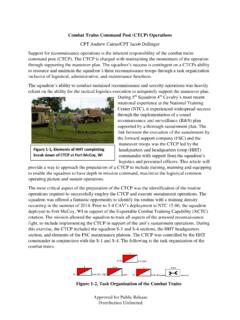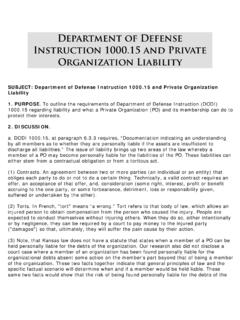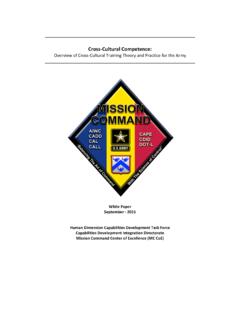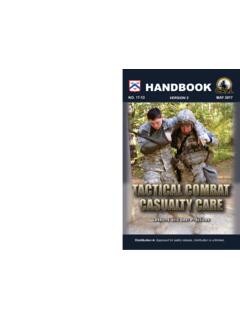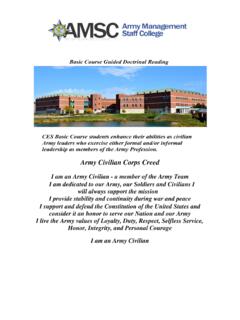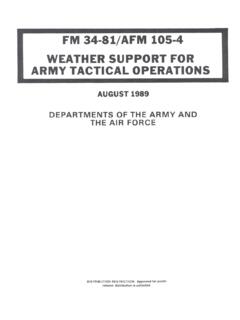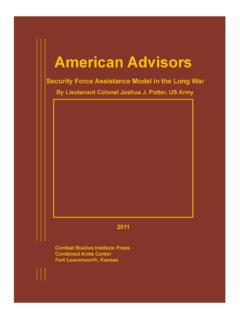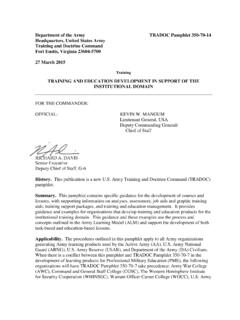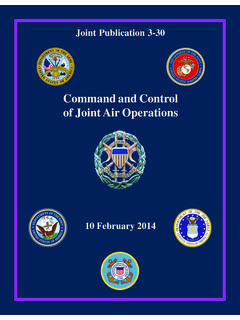Transcription of DIGITAL VERSION AVAILABLE - United States Army
1 DIGITAL VERSION AVAILABLEA DIGITAL VERSION of this CALL publication is AVAILABLE to view or download from the CALL website: of this publication is welcomed and highly to Master wargaming : commander and staff Guide to Improving Course of Action AnalysisFOLLOW CALL ON SOCIAL TO MASTER WARGAMINGHow to Master wargaming : commander and staff Guide to Improving Course of Action AnalysisTable of ContentsIntroduction1 Visualization7 Seeing Ourselves, the Enemy, and the Terrain8 Historical Vignettes9 Tools to Increase Proficiency in Visualization and Improve Course of Action Analysis17 Conducting a Commercial Wargame19 Choosing the Right Wargame24 Wargame Mediums25 Thoughts on Course of Action Analysis: Action, Reaction, Counteraction, and Adjudication29 Course of Action Analysis Methods33 Conduct of the Wargame (Action-Reaction-Counteraction)37 Wargame Rules and Methods38 Adjudication40 Correlation of Forces and Means42 Analog Correlation of Forces and Means and Step Losses44 Conducting Action-Reaction-Counteraction Cycles47 Wargame Vignette50 Thoughts on Training the Staff59 Example of a staff Training Plan63 List of Sample Commercial Wargames65 Appendix A.
2 Technical Assistance Field Team Task Guide: The Military Decisionmaking Process. Collective Task Number 71-8-511173 Appendix B. References85 Appendix C. Supplemental Resources 89ivCENTER FOR army LESSONS LEARNEDFile One: Course of Action Analysis ( wargaming ) Videos89 File Two: Professional Reading90 File Three: Supplemental Training Material93 Center for army Lessons LearnedDirectorCOL Christopher J. KellerCALL Lead AnalystMr. Richard AvernaCALL Contributing AnalystSpecial ContributorsMr. Donald N. MatcheckDr. James E Sterrett, Directorate of Simulation Education, CGSCMr. Michael B. Dunn, Directorate of Simulations Education, CGSCDr. Bruce Stanley and the School of Advanced Military StudiesThe Secretary of the army has determined that the publication of this periodical is necessary in the transaction of the public business as required by law of the otherwise stated, whenever the masculine or feminine gender is used, both are : Any publications (other than CALL publications) referenced in this product, such as ARs, ADPs, ADRPs, ATPs, FMs, and TMs, must be obtained through your pinpoint distribution TO MASTER WARGAMINGI ntroduction The general who wins the battle makes many calculations in his temple before the battle is fought.
3 The general who loses makes but few calculations beforehand. Sun Tzu The Art of WarVignette: National Training Center, Present DaySix days into a 14-day rotation at the National Training Center, the battalion had just completed its second force-on-force: A deliberate attack, breach, and assault. It had been a rough battalion commander made his way back to the tactical operations center, with his mission and the day replaying in his head: Clear Objective Omaha to facilitate the passage of an Armor Battalion Task Force in order to complete the brigade combat team s seizure of Objective the commander entered the tactical operations center, the S-3 was already back. The staff was around the map and the executive officer (XO) was thinking aloud. The course of action (COA) had seemed simple enough, and the wargame had been a breeze. The commander took off his helmet and sat down on a steel folding chair, sighing heavily.
4 That was ugly. It seemed almost from the beginning we were chasing the day. The S-3 began to explain, Yes sir, at about one kilometer across Phase Line Sprint, Alpha Company s (A Co s) lead platoon took two volleys of enemy tank fire, disabling two tanks and destroying one Bradley. That was a surprise. I was not sure where it was coming from. Then, we could see it was from Support by Fire (SBF) 1. SBF1 was just out of our range, so I set the section of mortars with us and put some suppression on it so A Co could begin bounding; they had to fight for the position. It seemed to be going okay, then one of the mortar tracks was hit with anti-tank fire. It looked like the enemy was pulling off the rise and A Co picked up its movement. As A Co occupied SBF1, its combat power was down to six M1s and three M2s. Mortar Section 1, down one track, was still en route to its position. Once on SBF1, we were fighting in two directions.
5 It took us forever to gain any effects needed to launch the breach and I m not sure we ever did. The enemy was more determined than in our wargame, and on top of that, made us fight for SBF1. We did not see that during the wargame, but we tried to address it during the combined arms rehearsal (CAR). 2 CENTER FOR army LESSONS LEARNEDThe commander sat up. Ok, one of the problems is right there. We have to get away from wargaming events at the CAR. The XO nodded in agreement before picking up the explanation. I was on the radio with the S-3 and the mortars used half their basic load and were down one tube. They were black on high explosives. A Co s expenditure of ammunition was higher than we wargamed. It forced us to shift some of the artillery fire to suppress the far right enemy platoon. That delayed the buildup of smoke on the main objective by about 40 minutes, or maybe longer. The fire support officer muttered, I am sure they will tell us in the after action review (AAR).
6 The commander sighed, How did that even happen? The XO continued, Our wargame did not include the movement, just the actions at the objective. I was trying to save time so we could get the order out quicker. We assumed A Co could move rapidly to SBF1. Speed was one of our criteria, and we did not visualize the enemy forward of the obstacle. As a result, the enemy engaged A Co earlier, which caused A Co to occupy SBF1 with less combat power and without mortar support. A Co also lacked the ammunition to sustain direct fires that could destroy enough of the enemy on Objective Omaha. The commander walked over to the map, There is a second issue we cannot just wave off: the enemy. We have to assume it will fight, is free thinking, determined, and will try to surprise us and throw us off. That is what we have to wargame. Visualize the what-ifs. The S-3 responded, Yes sir, and from that event on, our timing was off. Shifting some of our artillery from the breach to compensate affected the high explosives and smoke supporting the breach.
7 The smoke was dissipating when the breach was still ongoing and the enemy was not suppressed. We were losing tanks, and at that time, we had Bravo Company (B Co) send its tank platoon to reinforce Delta Company (D Co), and we had to commit Mortar Section 2 to support the breach instead of the assault. Our coefficient of forces, with one tank company and 45 minutes of artillery suppression and obscuration, won this in the wargame, but the enemy had voted and not in our favor! The XO thought to himself, Our wargame just consisted of filling in the events on the synchronization matrix, and a review of the decision support matrix. Everything we did was perfect. The enemy died where and when we wanted it to. We thought if we missed something, we could catch it at the CAR. 3 HOW TO MASTER WARGAMINGThe 3-291 Combined Arms Battalion (CAB) cleared Objective Omaha, but it was at a heavy cost. At the AAR that night, the cause and effect traced directly back to insufficient wargaming .
8 The commander stood up and stressed what he saw as shortfalls in the wargame, saying, We need to improve on the following: better understanding by the staff of its warfighting function, visualizing the fight with realistic adjudication of a thinking enemy, planning for and anticipating outcomes, synchronizing events and not just filling in a matrix, and finally, the CAR cannot be where we wargame. wargaming wargaming is a disciplined process, with rules and steps that attempt to visualize the flow of the operation, given the force s strengths and dispositions, threats, capabilities, and possible COAs, impact and requirements of civilians in the area of operations (AO), and other aspects of the situation. Field Manual (FM) 6-0 commander and staff Organization and Operations. 05 MAY is not the purpose of this handbook to repeat the doctrine on COA analysis. This handbook instead focuses on three items: First, how to improve and develop the cognitive skill of visualizing, a key component to COA analysis ( wargaming ); second, improving the methods and conduct of action, reaction, and counteraction adjudication of COA analysis with off-the-shelf wargames; and third, thoughts on training the focus on COA analysis?
9 It is identified across all combat training centers (CTCs) and other training events as being the one step in the military decisionmaking process (MDMP) where staffs have the most difficulty. Further, integrating off-the-shelf wargames into staff training can help develop better understanding of how to apply rules and judgments to realistically adjudicate outcomes in the action, reaction, and counteraction analysis ( wargaming ) is the fourth step in the MDMP and is arguably one of the most critical because it takes the commander s plan from concept to detail and synchronizes the unit s combat power for an operation. Recent observations of multiple units executing decisive action training environment rotations and Mission Command Training Program (MCTP) warfighter exercises (WFXs) have shown that battalions through division staffs do not conduct the wargame effectively. Staffs are challenged in visualizing events in time and space.
10 Also, a solid home-station training plan for the staff on the MDMP is lacking. This leads to issuing incomplete 4 CENTER FOR army LESSONS LEARNED plans to subordinate units, a lack of shared understanding across the army warfighting functions, and poor synchronization of all maneuver and support elements in the following are observations from maneuver CTCs, MCTP WFXs, and training: Staffs are untrained on the MDMP upon arrival at the CTC. Typically, staffs will only have conducted one to two iterations of MDMP training prior to their rotations. Conversely, majors leaving the Command and General staff College (CGSC) will have conducted eight to fourteen iterations of the MDMP before graduation. This number of repetitions could be a realistic goal for units prior to a deployment. Critical thinking can only be acquired in objective analysis in this case doctrinal-based analysis ( wargaming ) and applying that analysis to a tactical problem.
